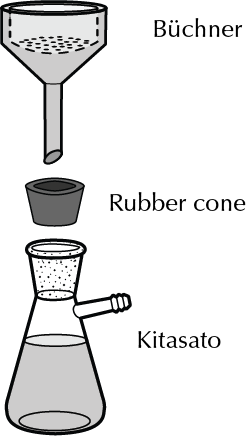Written by J.A Dobado | Last Updated on April 22, 2024
What is vacuum filtration?
Unlike the gravity filtration, vacuum filtration is used to separate a solid suspended in a solvent when what you want in the mix is solid. For example, obtaining crystals in a procedure recrystallization. The vacuum filtration is faster than gravity filtration, because the dissolution and the air are forced through the filter paper by the application of vacuum. You should not use the vacuum filtration to filter a solid from a liquid is the liquid that you want, and if the liquid has a temperature close to its boiling point. Any solvent with low boiling points will evaporate with the effect of the vacuum in the kitasato.
The equipment needed to perform a filtration vacuum is the following:
- Büchner: is a funnel-shaped sieve cylindrical (of porcelain or plastic) that has small holes in a flat bottom (see Figure). Place a piece of filter paper circle in the Büchner.
- Kitasato flask: resembling a Beaker in its tapered shape, but in the upper part protrudes a tube finished off to connect it to the outlet of a vacuum.
- Perforated stopper: it is placed between the Büchner and the Kitasato flask to fit well when it is performed in the vacuum.
- Vacuum trap: this device is inserted between the vacuum source and the Kitasato to prevent the liquid that remains in the Kitasato go to the machine that generates the vacuum.
- Filter paper circle.
- Vacuum pickup.
The filter flask must be secured to a rack or metal bracket by means of a clamp with nut.

Filtration process
- Cut a piece of filter paper circle, making sure that the filter is the correct size and it does not touch the walls of the Büchner or leaving the holes unfilled.
- Once placed the filter paper, the Büchner adjust to the Kitasato flask using the perforated stopper, setting the Kitasato flask with a clamp and nut to the grid.
- Connects the Kitasato flask the trap of making empty.
- The filter paper is moistened with a few drops of the same mixture of solvents that are filtered out so that it is completely stuck to the bottom of the Büchner.
- The mixture to be filtered is poured into the Büchner, and as in the gravity filtration, the solid is dropped with the help of a glass rod.
- Pour all of the liquid, using more solvent if it is necessary to drag the solid remaining that are attached to the vessel containing the mixture.
- Once the filtration is complete, disconnect the Kitasato flask from vacuum line, and then close vacuum gauge.
Vacuum filtration can also be performed for solid disposable. For example, when the gravity filtration is slow.
When the solids to the filter have a particle size of very small, the filter paper may not have a pore size small enough. In these cases, use funnels, cylindrical, with a plate or filter funnels, conical, called Hirsch funnels.
Pros and cons of vacuum filtration
Here are some pros and cons of vacuum filtration method:
Pros of vacuum filtration:
- Faster than gravity filtration, especially for large volumes of liquid or suspensions with high solid content.
- Can be used to filter very fine particles.
- Allows for more control over the filtration process, as the vacuum can be adjusted to optimize the flow rate and clarity of the filtrate.
Cons of vacuum filtration:
- Requires specialized equipment, such as a vacuum pump and filter flask
- Can be more expensive and time-consuming to set up and operate compared to gravity filtration.
- May not be suitable for filtering volatile or explosive liquids
- Can be less effective at removing fine particles when the filter media becomes clogged or fouled.
Video on vacuum filtration
References
- Isac-García, J.; Dobado, J. A.; Calvo-Flores, F. G.; and Martínez-García, H. (2015). Experimental Organic Chemistry Laboratory Manual. Elsevier Science & Technology. ISBN: 978-0-12-803893-2